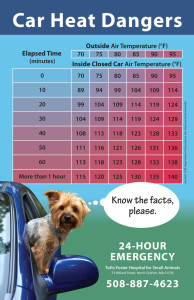Four-Legged Friends: Summer Care Tips
By Susan ScheideI may be one of the few people in Canton who would much rather walk in the cold than in the heat. When it’s cold, I can add a hat, an extra sweater, wool socks — the possible number of layers is almost endless. When it’s hot? There is only so much you can remove and not get arrested. And when it’s hot and humid, there is really no relief at all. Buck, my greyhound, completely agrees with me. At least it seems so. When the temperatures reach the 70s, my lean, mean, racing machine turns into a panting mess. Because I have no option other than to walk him for his bathroom needs and exercise, I’ve learned a few things about making sweltering days bearable.
Before I get into the details, let me ask, no, beg you all: do not leave your dog in the car in the summer. Period. It’s as simple as that. Please look at the chart I have borrowed from the Tufts Emergency Veterinary Clinic’s website. “I’ll only be gone for a minute” can turn into tragedy before you know it. It’s not worth the risk. Not too long ago I read that a police canine died because the specially equipped cruiser he was in got too hot and the warning alarm that was supposed to go off when the temperature rose failed. If a police dog in a special cruiser can die from overheating in the very expensive, very special vehicle used just for him, do you think your car is really safe? Just leave your canine friend at home. Thank you.
Now, back to how I survive the summer. Buck always thinks he wants to do our weekend “long walkies” even when it’s hot. Because I know that any temperature over 70 degrees makes him pant, I take him early in the day before it gets too hot. Once the sun is at its peak, we stay inside with the air conditioning on. If for some reason I can’t get him out before it’s hot, we just stay close to home and skip the long walk that day.
On weekdays, I listen to the weather every morning, and if the forecast is for 75 or higher, I close up my windows and turn on my air conditioning. I live on the top floor of my building, and it gets quite hot if I don’t. Greyhounds have almost no body fat or fur and are very vulnerable to both high and low temperatures.
Take care on super-hot days to avoid blacktop to the extent possible. You have shoes on; your dog doesn’t. Too much time on hot pavement can burn your dog’s feet.
If you have a long-haired dog (or cat), your instinct might be to shave him down in the summer. Please do not do that. Fur on a dog is like down on a duck. It insulates your dog against both heat and cold. Sure, the groomer might tell you it will cool your dog off, but it really won’t, and it will make your dog’s skin susceptible to sun burn.
“A dog’s coat is kind of like insulation for your house,” explains Dr. Louise Murray, vice president of the ASPCA Animal Hospital. “Insulation stops your home from getting too cold in winter, but it also keeps it from overheating in summer — and your dog’s coat does the same thing.”
Anyone with a white dog should take special care and consider using sunscreen on any exposed skin. White dogs generally have very fair skin — fair skin on a dog is very pale pink. Think of a white dog like a red-haired person — very prone to sunburn as well as skin cancer.
Keep fresh water available at all times for your dog as well as your cat. I don’t mean just a full bowl. I mean you should dump out the water and give fresh water every day — twice a day if necessary. Both dogs and cats prefer their water fresh and cold, and the goal is to encourage them to drink. My cat, Ming, always comes for a drink right after I give him a fresh bowl of water.
If you find your dog in distress after a walk, or playtime in the yard, apply cool, moist towels. Get them into the tub or a kiddy pool if possible, and use cool water (not ice cold). Allow your dog a drink, but do not let them gulp large amounts all at once. Know the signs of heat stroke, and know the location of the nearest emergency vet. Signs of heatstroke include: increased heart rate, excessive panting, increased salivation, bright red tongue, red or pale gums, thick, sticky saliva, weakness, vomiting, or diarrhea.
As heatstroke progresses, it can cause seizures, coma, cardiac arrest, and death. Tufts Veterinary Emergency is located in Walpole on 525 South Street. I believe they are the closest emergency vet to Canton. If your pet is ever in need of care and your regular vet isn’t open, they will be.
Just as I have to adjust my schedule around the heat for Buck, I’m no spring chicken and the heat bothers me more and more as I get older. So I wear lightweight clothing, and most importantly, a hat. When the sun isn’t beating down directly on your head, you just don’t get as hot. I learned this on my family trip to Africa. Rarely do you see a safari guide without a wide-brimmed hat on. Even if you aren’t concerned about sunburn, skin cancer, and wrinkles, a hat keeps the sun out of your eyes and does keep you cooler.
Common sense is your friend when it comes to beating the heat. Leave your dog at home if it’s really hot, and let me repeat, do not ever leave your dog in the car on a hot day. Happy summer everyone!
Short URL: https://www.thecantoncitizen.com/?p=33790











